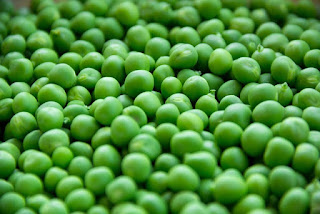Peas are a small, spherical seed or the seed-pod of the legume Pisum sativum. Each pod contains several peas, which can be green or yellow.
There are several varieties of peas, including:
Garden Peas (Green Peas): These are the common peas that are shelled and eaten without the pod. They have a sweet flavor and starchy texture.
Snow Peas: These are flat with very thin walls. The entire pod, along with the young peas inside, is eaten either raw or cooked.
Snap Peas (Sugar Snap Peas): A cross between garden peas and snow peas. The whole pod is eaten and has a crunchy texture and very sweet flavor.
Peas are high in fiber, protein, vitamins A, B6, C, and K, and minerals like magnesium, phosphorus, iron, zinc, and potassium. They're low in fat and can be a part of a healthy diet, helping in weight management, digestive health, and blood sugar regulation.
Peas are used in various culinary ways, including in soups, stews, curries, salads, and side dishes. They can be eaten fresh, frozen, canned, or dried, and they play a significant role in vegetarian diets as a source of plant-based protein.
Peas are not only a common kitchen ingredient but also come with a range of unusual and interesting facts:
A Long History: Peas are one of the oldest cultivated vegetables, with evidence of cultivation dating back to 9,800 years ago in Thailand.
Mendel's Experiments: Gregor Mendel, the father of modern genetics, used pea plants in his groundbreaking experiments in the 1860s. He observed the inheritance of traits in peas, which laid the foundation for the understanding of genetic inheritance.
Astronaut Food: Peas were among the first vegetables to be freeze-dried and taken into space due to their high nutritional value and ease of rehydration.
Royal Delicacy: In the 17th century, peas were considered a luxury item and were enjoyed by French royalty. Fresh peas were so expensive that they were eaten by the king's courtiers as a delicacy.
Nitrogen Fixing: Peas, like other legumes, have a symbiotic relationship with nitrogen-fixing bacteria. This means they can convert nitrogen from the air into a form that plants can use, enriching the soil where they are grown.
Pea Soup Fog: The term “pea-souper” was used to describe the thick smogs in London during the 19th and early 20th centuries due to their dense, green appearance, which was reminiscent of pea soup.
A Source of Pea Milk: Recently, peas have been used to make plant-based milk alternatives. Pea milk is known for being more environmentally friendly than almond milk and soy milk.
World Record for Pea Eating: The world record for eating peas with a cocktail stick is held by Janet Harris of Sussex who, in 1984, ate 7,175 peas one by one in 60 minutes.
Floating Medicine: In the 19th century, peas were used in the treatment of tuberculosis. The peas would be soaked in whiskey and then consumed.
Oldest Pea: The oldest pea ever found dates back to around 3,000 BC and was discovered in Thailand.





No comments:
Post a Comment